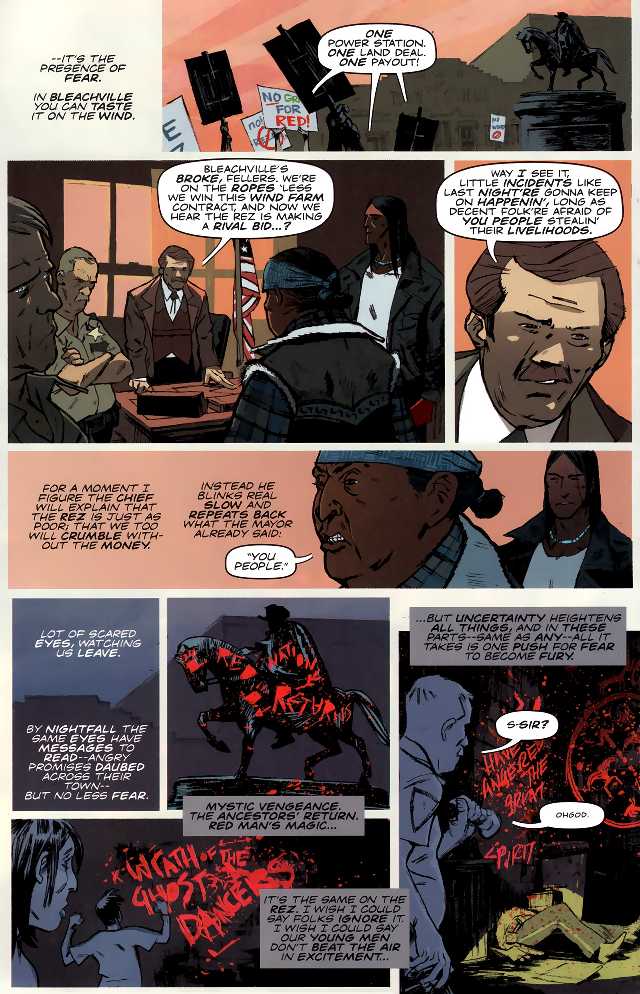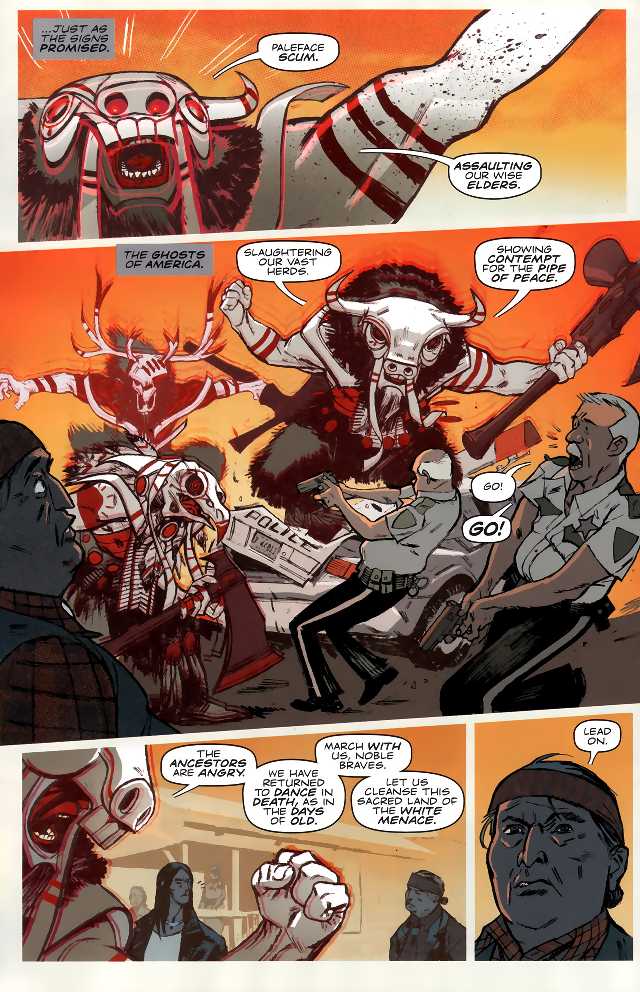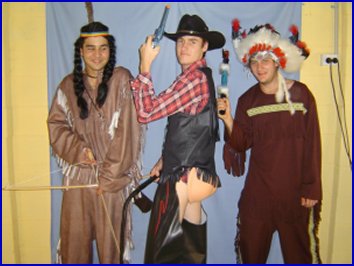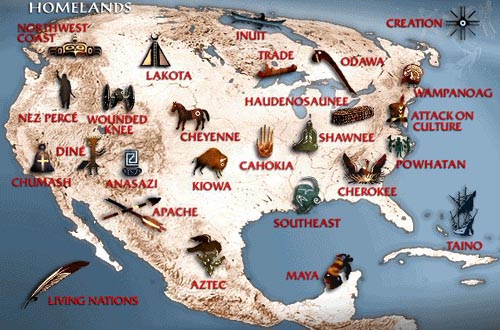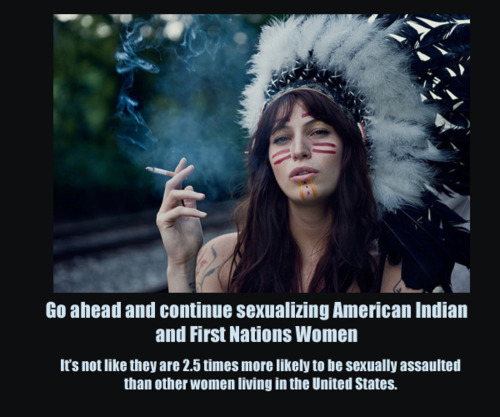The
20/20 special
Children of the Plains has gotten both
positive and
negative reviews. The episode certainly shone a light on a neglected part of America. For that alone, it provided a valuable service.
But the critics were right that it was a maudlin mess. It was closer to a morning-show puff piece than a hard-hitting PBS documentary. Here are some of its problems:
The tone is set early with Diane Sawyer calling the Lakota "hidden" and "forgotten." These terms may be accurate in some sense, but they're strangely bland and neutral. It's as if Americans wanted to help the Indians all along but couldn't find them.
That isn't the case, of course. In reality, words like "neglected," "scorned," or "betrayed" would work just as well. But those would shift the blame from the Indians to the white man, and Sawyer doesn't want that.The episode's first half is little but a grim litany of facts and images: unemployment, alcoholism, overcrowded trailers, crumbling floors and ceilings, etc. There's no explanation for why this is happening--merely a statement of its existence. Are the Lakota responsible for their own plight, or is someone--the government or big business--causing it? You won't learn the answers here.It's not hard to find explanations for this poverty. Here's one that appeared around the same time:
Senate
Committee
on
Indian
Affairs
Field
Hearing“H.O.P.E.
for
the
Future:
Helping
Our
People
Engage
to
Protect
Our
Youth”Like many Alaska Native people of my grandmother and mother’s generation, my mother endured the emotional, psychological, spiritual, cultural, and physical duress of a rapid transition from a traditional way of life on the land to the twenty-first century “city life.” Federal policy and practices, implemented through schools and some churches, enforced the assimilation of Native peoples through the direct and indirect eradication of rights, language, culture, and philosophy. My mother’s generation was born into a world that immediately told her, both in popular culture and in government policies, that she must change.
The policies and practices of colonization brought with it the social illnesses of sexual abuse, alcoholism, and neglect, which can be passed from one generation to the next. This is often referred to as intergenerational trauma, which equates to an experience of post-traumatic stress disorder among many Alaska Native people. In many ways, my mother’s generation was born with the scars of assaults carried out in previous generations of our ancestry as the colonizing culture attempted the eradication of who we are and the undermining of our control over our destiny as a people.Myriads of Native or non-Native experts could've made these points in a minute or two. But Sawyer isn't interested. You have to ask yourself why.
Without this kind of narrative, many viewers will blame the Indians themselves. And Sawyer seems to be okay with that. She wants you to think in simplistic terms: The children are in trouble but you can help them. Watch this show and feel good about yourself for caring.
Cry, babiesThe stories are manipulative to the point of tears--literally. A boy cries because his mother is an alcoholic. A girl cries because she tried to commit suicide. The school principal, an old lady in a motorized chair, cries because her work is so difficult. She's the only adult who seems to care, but she's too feeble to do anything about it.Even when the subjects don't break down and cry, their stories are framed negatively. Another girl gets pregnant and thinks her future is ruined. A five-year-old's father is killed in a drunk-driving accident.
It's not that any of these stories are false or unrepresentative. But they seem chosen for the maximum heart-tugging effect. You'll suffer with the children in the first half, and you'll feel their joy as things improve in the second half.
There's a term for this: "poverty porn." Here's how it works:
What is ‘poverty porn’ and why does it matter for development?As I’ve come to believe, poverty porn, also known as development porn or even famine porn, is any type of media, be it written, photographed or filmed, which exploits the poor’s condition in order to generate the necessary sympathy for selling newspapers or increasing charitable donations or support for a given cause. Poverty porn is typically associated with black, poverty-stricken Africans, but can be found elsewhere. The subjects are overwhelming children, with the material usually characterized by images or descriptions of suffering, malnourished or otherwise helpless persons.Not only does the episode's first half ignore the causes of poverty, it barely mentions the outside world. When it does, it uses the passive tense. Schools were forbidden to teach the Lakota language. Children were removed to boarding schools.Well, who ordered these things done? Why did they happen? And what were the consequences? Again, you won't learn the answers here.
Only in the second half does Sawyer mention America's sins a couple times: broken treaties, slaughtered buffalo, stolen land, unhealthy commodity food. But by then it's too little, too late. The "poverty porn" feeling predominates.
Sawyer presents two Lakota "talking heads," and they offer some corrections to the narrative. But they're young and polite, and Sawyer puts them on the defensive. Surely the federal government isn't responsible for creating jobs on the rez? she asks the young man. Why do the Lakota cling to the reservation when they could leave? she asks the young woman.Imagine all the sharp-tongued activists--people like Russell Means and Winona LaDuke--who could've ripped the show's passive hand-wringing to shreds. Or the tribal leaders and elders who could've spoken more forcefully on the issues. Sawyer doesn't lift a finger to find such people; she seems to go out of her way to avoid them.
Where are the adults?Similarly, where are all the people trying to make a difference? For every problem on the rez, there are scads of media reports, government hearings, tribal programs, charities and foundations, etc. People address problems such as suicide and domestic violence every day. An issue such as Whiteclay's alcohol sales, which the show touches upon, has inspired protests, lawsuits, and documentaries.True, no one's come up with a silver bullet to end these problems, but they've received a huge amount of attention lately. Even if the efforts haven't succeeded yet, the show could've mentioned the attempts. You'd never know people are working on these problems from
Children of the Plains.
The show does mention one program fighting alcoholism. And it devotes a fair amount of time to Red Cloud, a successful private school. Great, but those are limited "solutions" to a wide range of problems. When a parent has to leave her children and take two jobs in the city to support them, a good school isn't enough.
Moreover, the show offers a whiff of conservative ideology in place of thoughtful discussion. This is evident in glimpses of Native American Foods, makers of the Tanka Bar, and a Subway sandwich shop. It's as if no government program is worth mentioning and only free enterprise can save the Lakota.
Never mind that several factors--bureaucratic red tape, banks unwilling to make loans, sheer distance from population centers--conspire to thwart Lakota entrepreneurship. Sawyer acts as she's found an answer no one else thought of. If only the Indians would open some Subway shops, she implies, their employment and health problems would disappear.
Have you seen documentaries where the narrator is invisible and the subjects speak directly to the cameras? As if you're capturing a slice of life without outside interference? This isn't one of them. Diane Sawyer is everywhere. She walks with the children...rides with them...sits with them...tries to speak their language...to do one of their dances...etc. She's there when someone needs a hug or an encouraging word.The show needs less of her and more of the things I've mentioned. Instead of Sawyer smiling at children, feature some of the Lakota who are making a difference. Talk about the efforts underway to fight violence, substance abuse, poor health, and so forth. Don't act as if no one knew about Pine Ridge until the white woman discovered it.
ConclusionChildren of the Plains exists mainly as poverty porn for white audiences. Summing up its message: No one knows about the hidden, forgotten plight of the Lakota. Compassionate white woman goes where others fear to tread. The children are suffering and sad, but she brings a smile to their faces. No one else cares about these people; no one is trying to help them. But Diane has opened her heart to them, and you can too.
A more honest documentary would put the "plight" in context. How did the poverty come about? What's keeping the rez poor? What are people doing about it?
But that would require a complex discussion of cause and effect. It would blunt the focus on Sawyer and the children. If viewers knew how intractable the problems were, they might not open their hearts and wallets. They might shrug and change the channel instead.
Sure, the show's focus on the children is undoubtedly a good thing. It humanizes the abstract problems and coaxes viewers to care. The predictably uplifting ending encourages them to think they can make a difference. If Diane Sawyer can waltz onto the rez and change a few lives, maybe they can too.
That's nice, but
Children of the Plains spent too much time on its manipulative message. It could've cut 10-15 minutes of the sad stuff and devoted that time to providing context instead. Viewers would want to help the children still, but they'd have a better understanding of the issues, too.
This approach would've educated them on the long-term structural problems facing many reservations, not just Pine Ridge. It would've taught them to reject anti-Indian bigotry such as the "blame the victim" dogma espoused by conservatives. It would've inspired them to work for progressive change that benefits Indians as well as the rest of the 99%.
So
Children of the Plains achieved its first-level goal of raising awareness. It didn't achieve the second-level goals of increasing understanding or inspiring action. And that's after Diane Sawyer spent a year and a half filming on the rez. All that time and money to produce an average news segment--what a waste.
For more on the subject, see
Viewers Respond to Children of the Plains and
Children of the Plains on 20/20.

